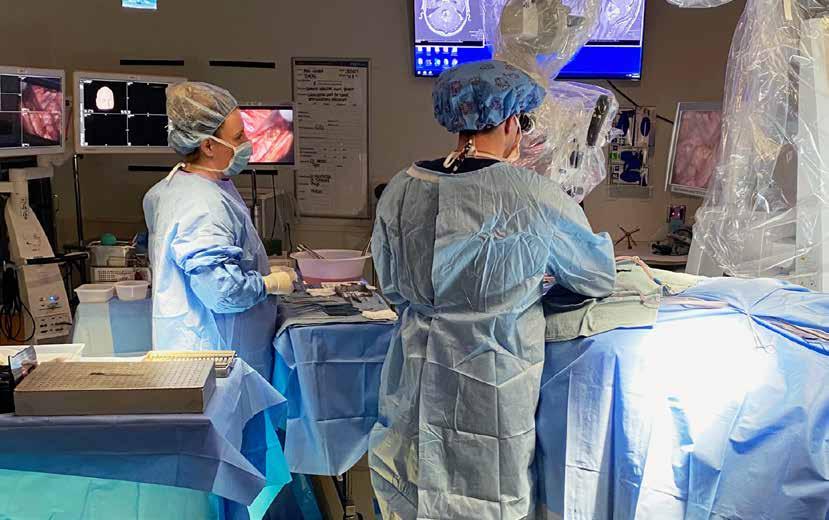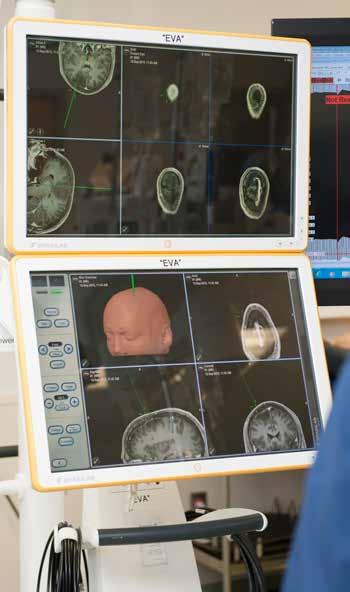
13 minute read
UR Medicine Wilmot Cancer Institute’s Neuro-Oncology Clinic Provides
Randi Minetor
Advertisement
Left to right: Nimish Mohile, MD, Sara Hardy, MD, Tyler Schmidt, MD and Michael Milano, MD, PhD
With advances in cancer treatment in recent years leading to higher survival rates, a new phenomenon has emerged in cancer care: patients whose initial cancer goes into remission, but recurs months or years later as a metastasis elsewhere in the body. Many of these metastases occur in the brain or spine, said Tyler Schmidt, DO, neurosurgeon at UR Medicine.
“With the advent of targeted therapy and immunotherapy as well improvements in radiotherapy, prognosis is better for some patients with cancer and people are living longer,” Dr. Schmidt said. “So the management of these patients is a whole new entity requiring multi-disciplinary care integration. It’s good news, but it’s a Dr. Tyler Schmidt very different set of problems to solve.”
This is one of the reasons Dr. Schmidt chose to remain at UR Medicine. He received specialized training in neurosurgical oncology during his residency at the University of Rochester School of Medicine and Dentistry with Kevin Walter, MD, neurosurgical oncology surgeon and surgical leader of the UR Medicine Wilmot Cancer Institute’s neuro-oncology program. He also completed a neurosurgical oncology fellowship at Geisinger Medical Center in Pennsylvania under the direction of Michel Lacroix, MD. “During the year fellowship at Geisinger, I participated in the multidisciplinary tumor management concept they were using there,” Dr. Schmidt continued. “We had already been using it here, and with that focused year I gained further appreciation for its value. I was happy with the neuro-oncology programmatic vision here at UR Medicine, and I am excited to join our team.”
Dr. Schmidt became part of the UR Medicine Wilmot Cancer Institute’s new Brain and Spine Metastasis program, the only one of its kind in upstate New York. With the coordination of neuro-oncology, radiation oncology, neurosurgery, and the primary oncologist, the team develops specialized and per-
sonalized care plans that optimize quality of life and improve survival for patients with metastatic disease to the brain and/ or spine. “If you go back more than 20 ago, when tumors from other cancers spread to the brain or spinal cord, they were considered fatal and not much was done outside of palliative measures,” Dr. Kevin Walter said Dr. Walter. “Now we are more aggressive and we do better with these patients, and many of them survive years and years.” These cases of patients with metastases have become a new realm for neuro-oncologists, who normally treat glioblastoma and other cancers that first reveal themselves as tumors in the brain or spinal cord. “The need is actually Dr. Michael White coming out of the success we are having with oncology in general,” said Dr. Walter. “These patients are more prone to seizures and issues with neurocognitive function, so they are different from what the primary oncologist deals with.”
Dr. Walter, Dr. Schmidt, and colleagues including medical neuro-oncologist Nimish A. Mohile, MD, and radiation oncologist Michael Milano, MD, PhD, formed the neuro-oncology program to focus on these complicated cases. “There are more and more of those patients who need specialized care,” Dr. Walter said. “We become the team that monitors and treats the tumors that have spread to the brain, working to preserve speech and motor functions.”
So great has the demand been for treatment of brain and spinal cord metastases that the program expanded its staff over the last several months, said Dr. Walter. “We added a whole team, with oncologists Sara J. Hardy, MD, and Michael White, MD—another person in each of the specialties. We had to do it, just to deal with the volume of patients.”
During Neuro-oncologic procedures, the team utilizes multiple advanced technologies to keep patients safe, including neuromonitoring and (pictured here), stereotactic functional neuro-navigation, a GPS for the brain and spine

Complicated tumors
What makes these cases so complex? Many of them begin with types of cancer that do not initially involve the brain and spinal cord, but move into the central nervous system later in the pathology’s course. “When it is metastic, it is important that one understands the biology and treatment strategy up until that point,” said Dr. Schmidt. “The management of the primary lesion can be different from treatment of metastasis of the brain and/or spine. That’s why a specialty program is warranted, to integrate the care pathway on an individual basis.”
The primary cancer—perhaps in the breast, colon, lung, or kidney, or from melanoma—can move through the bloodstream or the lymph system to the brain, spinal cord or spine, where it takes hold. Some will cause symptoms that make the new tumor detectable early in the disease’s course, while others take longer to form. Any kind of cancer can metastasize and reach the brain, though the ones listed above put the patient most at risk for this. The Mayo Clinic notes that 10 to 30 percent of adults with cancer develop brain or spine tumors as the cancer progresses.
Brain tumors in patients with other cancers are usually detected through a series of examinations and tests, including a
basic neurological exam to check vision, hearing, strength, reflexes, sensation, and overall coordination and balance. If this exam turns up an issue, the primary care physician may order magnetic resonance imaging (MRI) to reach a diagnosis. Specialized imaging including a functional MRI, which looks for changes associated with blood flow; or magnetic resonance spectroscopy, which measures biochemical changes in the brain, may assist in the diagnosis.
Once the tests reveal the nature of the metastasis, the patient may be referred to the neuro-oncology team. The entire team
evaluates the patient in a multidisciplinary fashion. “We reach a consensus about the best management, and then we return to the original oncologist and integrate them into our recommendations,” said Dr. Schmidt. “For example, if you have lung cancer, and you have a mental status change and find that you have a new metastatic brain tumor, your primary oncologist will continue to take care of your lung cancer, and our team will manage the treatment of your lung to brain metastasis, whether it be neurosurgery, radiotherapy, or additional medical therapy. We want everyone on the same page, so there is no discontinuity or conflict of treatment strategy for patients.”
The patient experience
The treatment process can involve every aspect of cancer care, from surgery to chemotherapy and radiotherapy. “The difficult thing for patients with brain tumors in particular is that treatment is becoming increasingly complex,” Dr. Walter said. “It’s very helpful to the patients to have a unifying source that coordinates their care over multiple specialties. Gone are the days when you could have surgeons decide what they were going to do, and then the medical or neuro-oncologists’ and radiation oncologists’ input would come later. We need to coordinate between them.”
Patients enter the neuro-oncology clinic through one of two

points, he said. “The one I like least and would like to get away from is the emergency room. A lot of patients find out they have a brain tumor because they have a seizure out of the blue or they get a bad headache, and a CT or MRI scan shows they have a tumor. Emergency rooms are very busy places—they are Dr. Nimish A. Mohile hectic, and are not conducive to healing.”
The neuro-oncology team moves quickly to extricate the patient from that environment, working to establish a care plan that can take place in a calmer setting. For many patients, their first point of contact with the neuro-oncology team is in the clinic’s offices. “We arrange office visits within 24 hours, when they’ve had an MRI and their primary care physician sends them to us,” said Dr. Walter. “Then we have specialists from neurosurgery, neuro-oncology, and radiation oncology, all sitting with them in the same clinic. The patient will meet with all of us, depending on what their needs are. They don’t have to go to three different places to talk about their tumor.”
This multidisciplinary tumor board meets regularly to discuss each patient’s care, involving everyone from the surgeon to the radiation oncologists, medical oncologists and neuro-oncologists, as well as the nurse practitioners, nurse navigators, neuroradiologists and neuropathologists. “We sit down and create an expert consensus,” said Dr. Schmidt. “There are plusses and minuses to every treatment decision, so everyone weighs in on it, weighs in on it, ultimately coming to a conclusive care plan. ”
Everyone on the neuro-oncology team specializes in tumors of the brain and central nervous system. “Right now we have five neuro-oncologists, so we’re one of the largest programs in the country,” said Nimish A. Mohile, MD, whose specialty is medical neuro-oncology. “We have physicians focused on treating primary brain tumors, brain metastases, older patients, cognitive problems related to cancer, and neurologic side effects from cancer and cancer treatments.” “This is what they do every day, so they know how to talk with patients, to interact with them, to care for them,” said Dr. Schmidt. “This is true for every member of your care team, including the physical therapist or nurses who works with brain
The Wilmot Cancer Institute offers the area’s only Survivorship Program, where each patient receives a comprehensive, personalized survivorship plan.


The Neuro-Oncology program within itself provides extensive support services for patients and their families. It hosts the Adult Brain Tumor Network monthly support group for those with a diagnosis of a primary brain tumor and their caregivers. The program also hosts a free, day-long Caregiver workshop for family and friends who are caring for an adult with a primary brain tumor, that which focuses on tools and strategies for caregivers and an opportunity to connect with others. In addition, the ‘Sharing Hope’ Picnic, a free event open to adult and pediatric brain cancer patients, survivors and their families, is held each Spring to celebrate survivorship.
The patient’s diagnostic images like CT or MR are uploaded into the image guided system (IGS) where the doctor can then create a plan for the surgery
and spine metastasis patients routinely and know the nuances of this disease process, and can care for them in a personalized way; or the neuro-anesthesiologist who focuses on neurosurgery applications and can administer specialized anesthesia for neurosurgical interventions. Schedulers and support staff know how to be appropriately sensitive and efficient with people with a serious diagnosis. Everyone here is specific to this issue, and knows how to take care of you in a compassionate manner.”
This allows for a higher quality of care and more familiarity with the patient, he said. “A nurse who deals with neurooncology all the time has a much better radar for what may not be working. They can recognize and care for the patient in the most appropriate way possible. This is what elevates us.”
This team approach may include other services at UR Medicine, such as multispecialty rehabilitation and quality of life. “For example, if someone brings up that we should do another round of chemotherapy or radiotherapy, and someone else says the patient can’t get to the infusion center, we can arrange for them to have transportation through the Wilmot Cancer Institute’s resources for improving quality of life,” said Dr. Schmidt.
In addition, not every case results in a cure. “Addressing endof-life decisions is also part of the specialized process,” he said.
During the pandemic, the clinic managed to continue to interact with and treat patients while keeping these high-risk individuals safe, said Dr. Walter. “The strength of the program is our ability to communicate with patients in this efficient and friendly setting,” he said. “This was very difficult during the pandemic. When COVID-19 was at its peak, we were doing a lot of telemedicine visits. It was OK for a month or two; it would have been difficult to practice medicine like that indefinitely. It was challenging to get a sense of how someone is doing over Zoom visits with a little camera. But because we have such a good relationship with our patients, it got us through that time. Now we have more of a chance to work with them in person.”
Advances and clinical trials
“We are seeing patients live longer,” said Dr. Mohile, “because there are advances that have made treatment of brain tumors and brain metastases more effective. We take a careful look at tumor tissue, and we have new ways to evaluate it to discover certain markers.”
This advantage comes from the growth of precision medicine, he said. “We can target specific markers on these tumors with specific treatments. Instead of the old days when chemotherapy
was about killing every cell that grows fast, we can now target specific parts of the cancer cell. This is turning out to be more effective than the older treatments, with fewer side effects.”
Having the technology to treat brain metastases makes the difference in addressing complex cases, said Dr. Milano, who leads the clinic’s radiation oncology function. “If the patient has more than a few brain metastases, we can treat that with focused radiotherapy. We have acquired the software, hardware, and expertise to do this.”
Before the targeted therapies used today, the default was to treat the entire brain with radiation, Dr. Milano noted. “The patient can develop cognitive decline from that, and it might limit their treatment options down the road,” he said. “If you irradiate the whole brain, you can offer radiosurgery in the future, but you put the patient through risks that might not be appropriate for all patients. While we treat some patients with whole-brain therapy, we only consider that when radiosurgery may be of limited use or too risky.”
The opportunity to participate in clinical trials can be very important to patients, giving them access to treatments in the experimental stages that might turn out to improve their prognosis. “We offer clinical trials patients can’t get elsewhere in the region,” said Dr. Mohile. As of the end of August, he and his colleagues were reviewing three new trials for a potential September launch, with a fourth one in the works. “We have cooperative group studies, sponsored by the National Institute of Health’s National Cancer Institute,” said Dr. Milano. “We also have investigator-initiated studies—a physician or PhD researcher from the Wilmot Cancer Institute would be initiating these. We also open industry-sponsored trials from drug companies.”
The level of expertise resident at the brain and spine metastasis clinic gives the UR Medicine Wilmot Cancer Institute the opportunity to attract a range of trials, from drugs to technology, said Dr. Walter. “We have the ability to use tumor fluorescence, functional MRI to plot a safe path for surgery—these are not available at every medical center. We can do radiation techniques and chemotherapy trials that other medical centers cannot. It’s a great program to be part of, to be able to offer these things in the Rochester area.”
Randi Minetor is the author of Medical Tests in Context: Innovations and Insights (Greenwood, 2019), and is a freelance journalist based in Rochester.










